1997 CHEVROLET BLAZER light
[x] Cancel search: lightPage 192 of 402
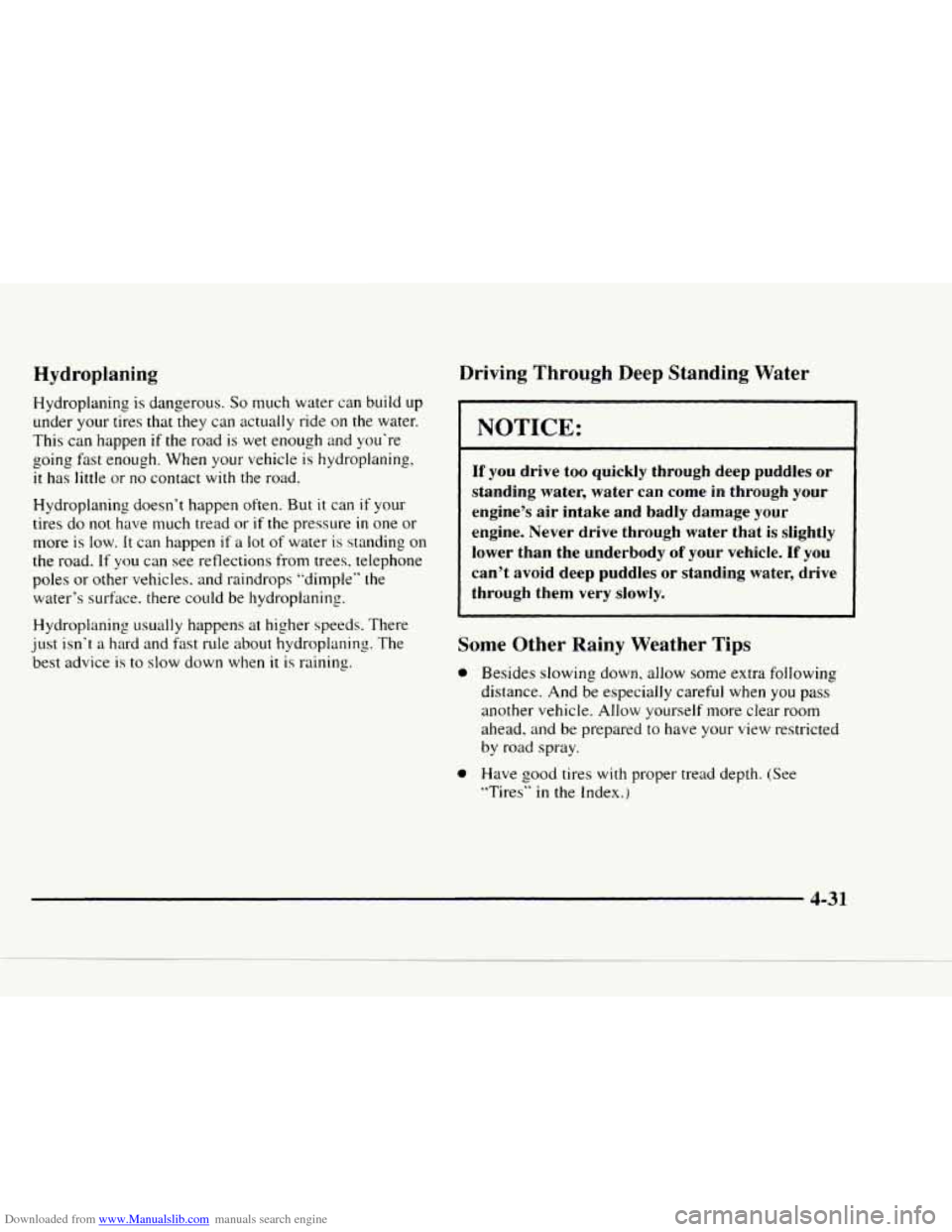
Downloaded from www.Manualslib.com manuals search engine Hydroplaning
Hydroplaning is dangerous. So much water can build up
under your tires that they can actually ride
on the water.
This can happen
if the road is wet enough and you’re
going fast enough. When your vehicle is hydroplaning,
it has little or no contact with the road.
Hydroplaning doesn’t happen often. But
it can if your
tires do
not have much tread or if the pressure in one or
more
is low. It can happen if a lot of water is standing on
the road.
If you can see reflections from trees. telephone
poles or other vehicles. and raindrops “dimple“ the
water’s surface. there could be hydroplaning.
Hydroplaning usually happens at higher speeds. There
just isn‘t
a hard and fast rule about hydroplaning. The
best advice is to
slow down when it is raining.
Driving Through Deep Standing Water
I NOTICE:
If you drive too quickly through deep puddles or
standing water, water can come in through your
engine’s
air intake and badly damage your
engine. Never drive through water that
is slightly
lower than the underbody
of your vehicle. If you
can’t avoid deep puddles or standing water, drive
through them very slowly.
Some Other Rainy Weather Tips
0 Besides slowing down, allow some extra following
distance.
And be especially careful when you pass
another vehicle.
Allow yourself more clear room
ahead, and be prepared to have your view restricted
by road spray.
0 Have good tires with proper tread depth. (See
“Tires” in the Index.)
4-3 1
Page 193 of 402
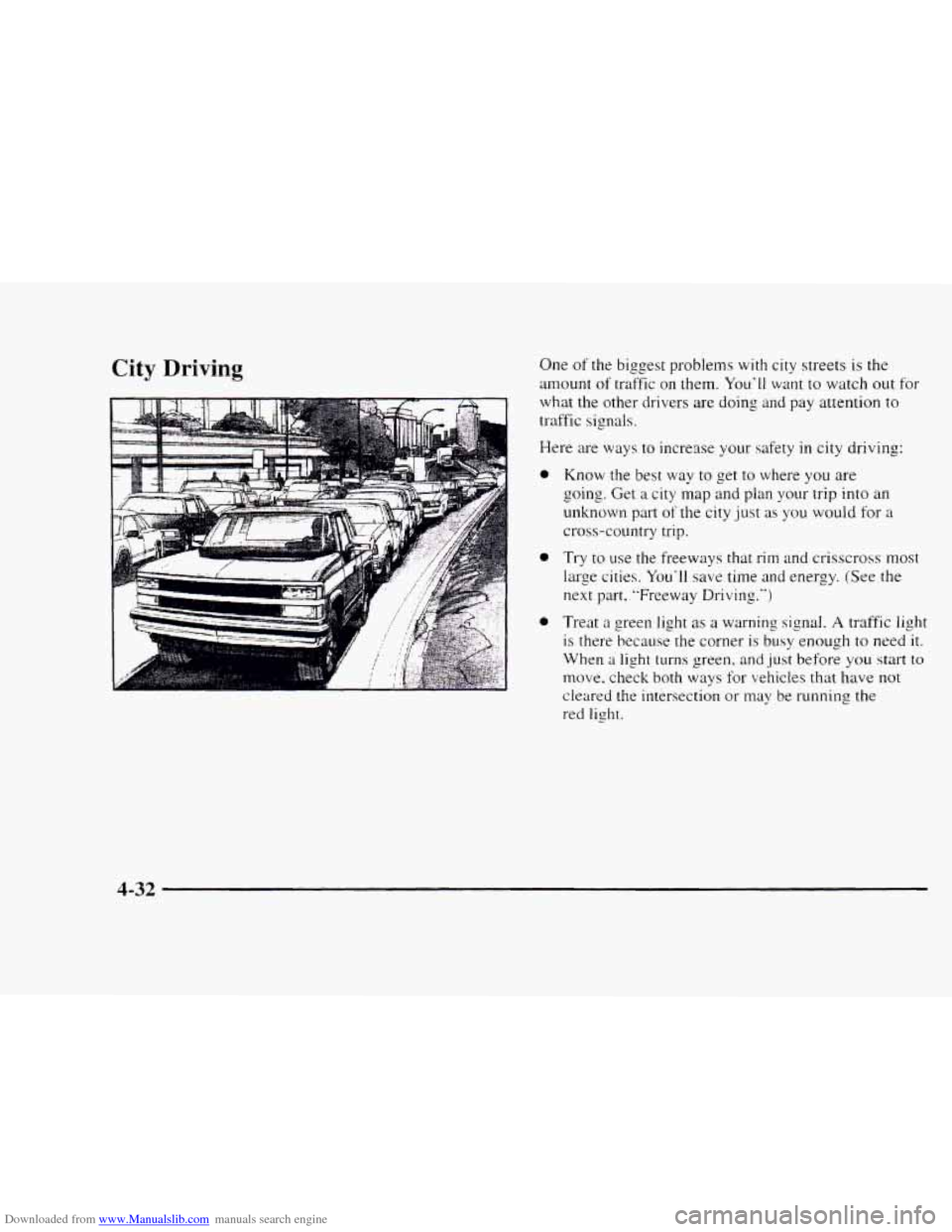
Downloaded from www.Manualslib.com manuals search engine City Driving One of the biggest problems with city streets is the
amount of traffic on them. You'll want to watch out for
what the other drivers are doing and pay attention to
traffic sipals.
Here are ways to increase your safety in city driving:
a
a
a
Know the best way to get to where you are
going. Get
a city map and plan your trip into an
unknown part
of the city just as you would for a
cross-country trip.
Try to use the freeways that rim and crisscross most
large cities. You'll save time
and energy. (See the
next part. "Freeway Driving.")
Treat
a green light as a warning signal. A traffic light
is there because the corner is busy enough
to need it.
When a light turns green. and just before you start to
move. check both ways for vehicles that have not
cleared the intersection or may be running the
red light.
4-32
Page 195 of 402
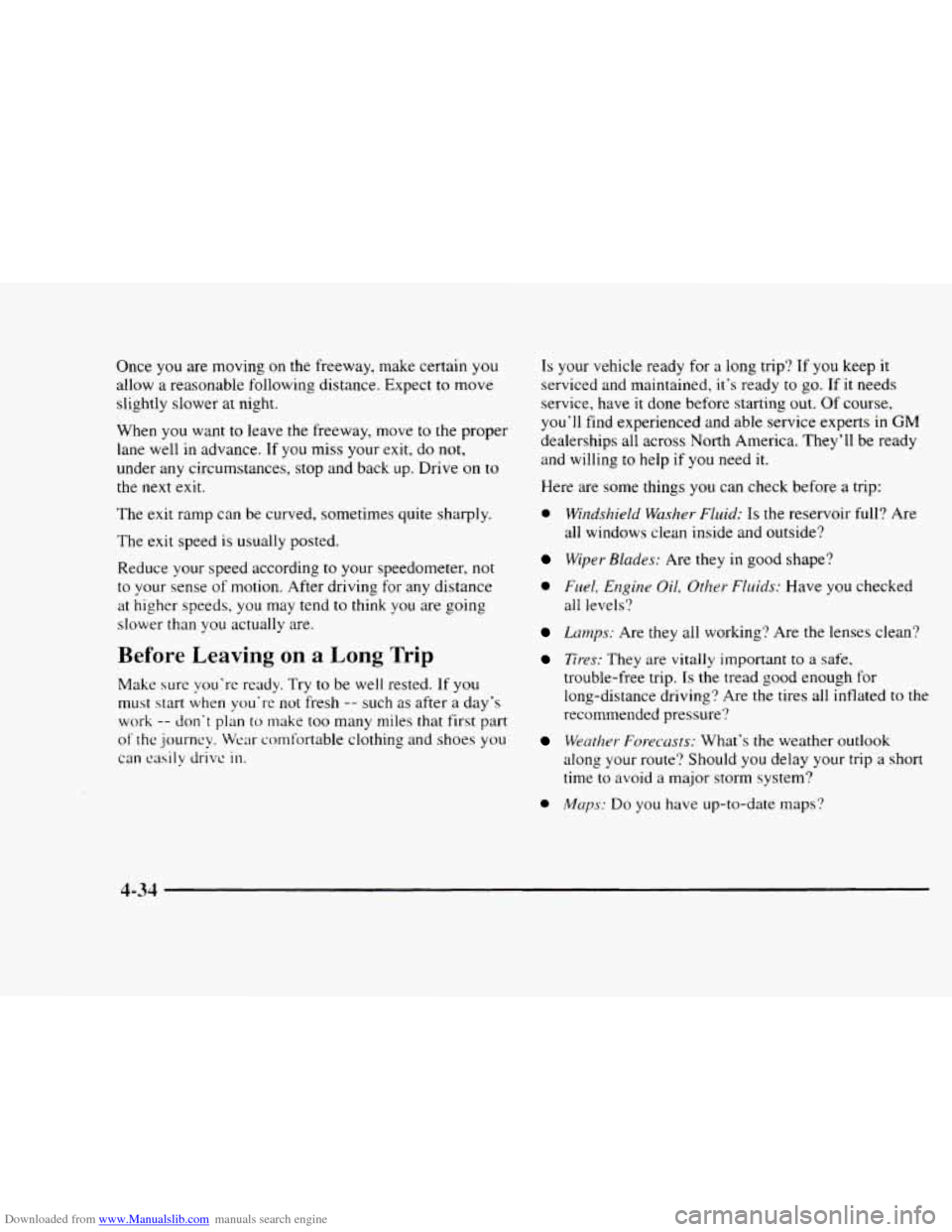
Downloaded from www.Manualslib.com manuals search engine Once you are moving on the freeway, make certain you
allow a reasonable following distance. Expect to move
slightly slower at night.
When you want
to leave the freeway, move to the proper
lane well
in advance. If you miss your exit, do not,
under any circumstances, stop and back up. Drive on to
the next exit.
The exit ramp can be curved, sometimes quite sharply.
The exit speed is usually posted.
Reduce your speed according to your speedometer,
not
to your sense of motion. After driving for any distance
at higher speeds, you may tend to think you are going
slower than
you actually are.
Before Leaving on a Long Trip
Make sure you're ready. Try to be well rested. If you
must start when you're not fresh -- such as after a day's
work -- don't plan to make too many miles that first part
of the journcv. Wear comfortable clothing and shoes you
can easily drive in.
Is your vehicle ready for a long trip? If you keep it
serviced and maintained,
it's ready to go. If it needs
service, have
it done before starting out. Of course,
you'll find experienced and able service experts
in GM
dealerships all across North America. They'll be ready
and willing to help if
you need it.
Here are some things you can check before a trip:
0 Windshield Washer Fluid: Is the reservoir full? Are
all windows clean inside and outside?
Wiper Blades: Are they in good shape?
0 Fuel, Engine Oil, Other Fluids: Have you checked
all levels?
Lurrzps: Are they all working? Are the lenses clean?
Tires: They are vitally important to a safe,
trouble-free trip.
Is the tread good enough for
long-distance driving? Are
the tires all inflated to the
recommended pressure'?
Weather For-ecvrsts: What's the weather outlook
along your route? Should
you delay your trip a short
time to avoid
a major storm system?
0 Maps: Do you have up-to-date maps'!
4-34
Page 198 of 402
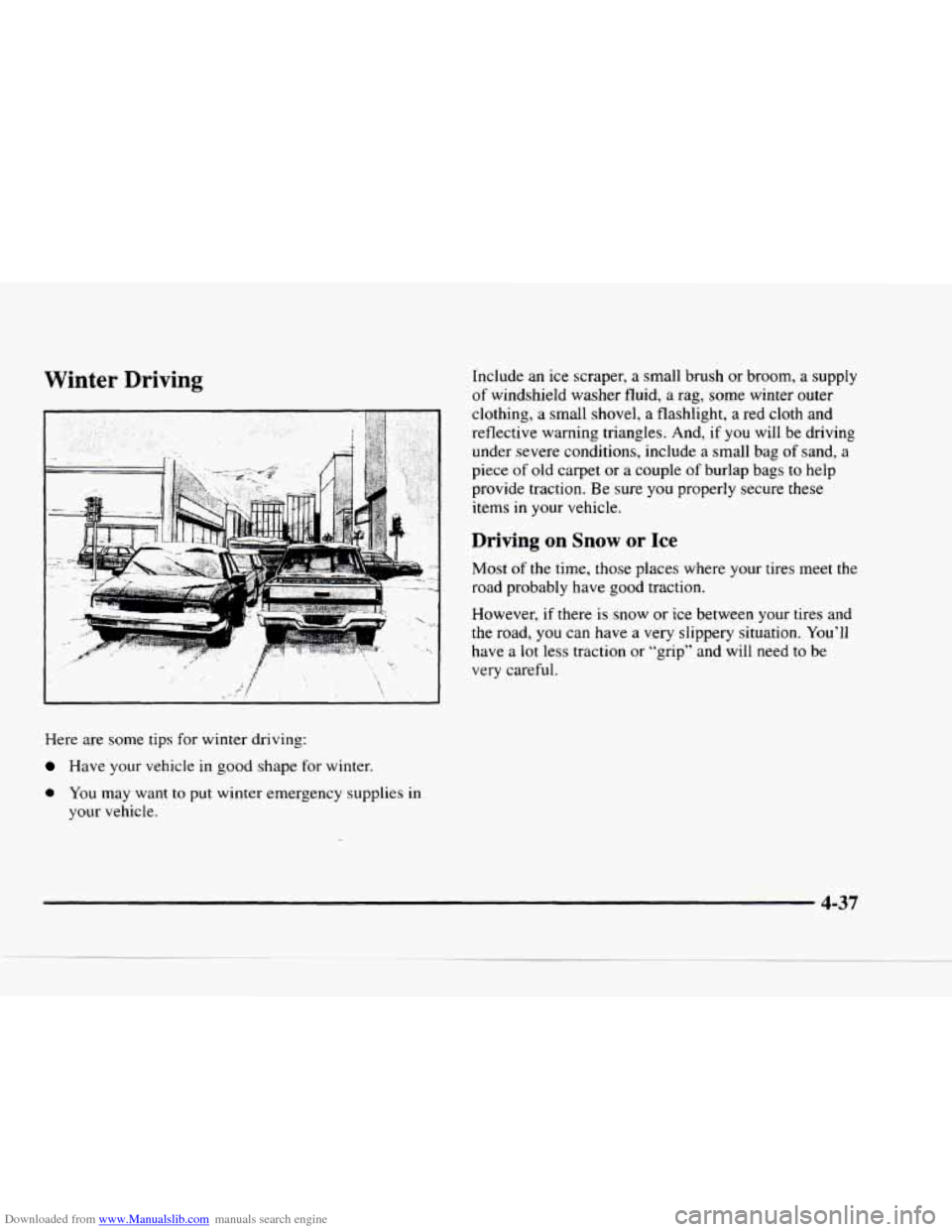
Downloaded from www.Manualslib.com manuals search engine Winter Driving
Here are some tips for winter driving:
Have your vehicle in good shape for winter.
0 You may want to put winter emergency supplies in
your vehicle. Include an ice scraper,
a small
brush or broom, a supply
of windshield washer fluid, a rag, some winter outer
clothing, a small shovel,
a flashlight, a red cloth and
reflective warning triangles. And, if you will be driving
under severe conditions, include a
small bag of sand, a
piece of old carpet or a couple of burlap bags to help
provide traction. Be
sure you properly secure these
items in your vehicle.
Driving on Snow or Ice
Most of the time, those places where your tires meet the
road probably have good traction.
However, if there is snow or ice between your tires and
the road, you can have a very slippery situation.
You’ll
have a lot less traction or “grip” and will need to be
very careful.
4-37
Page 201 of 402
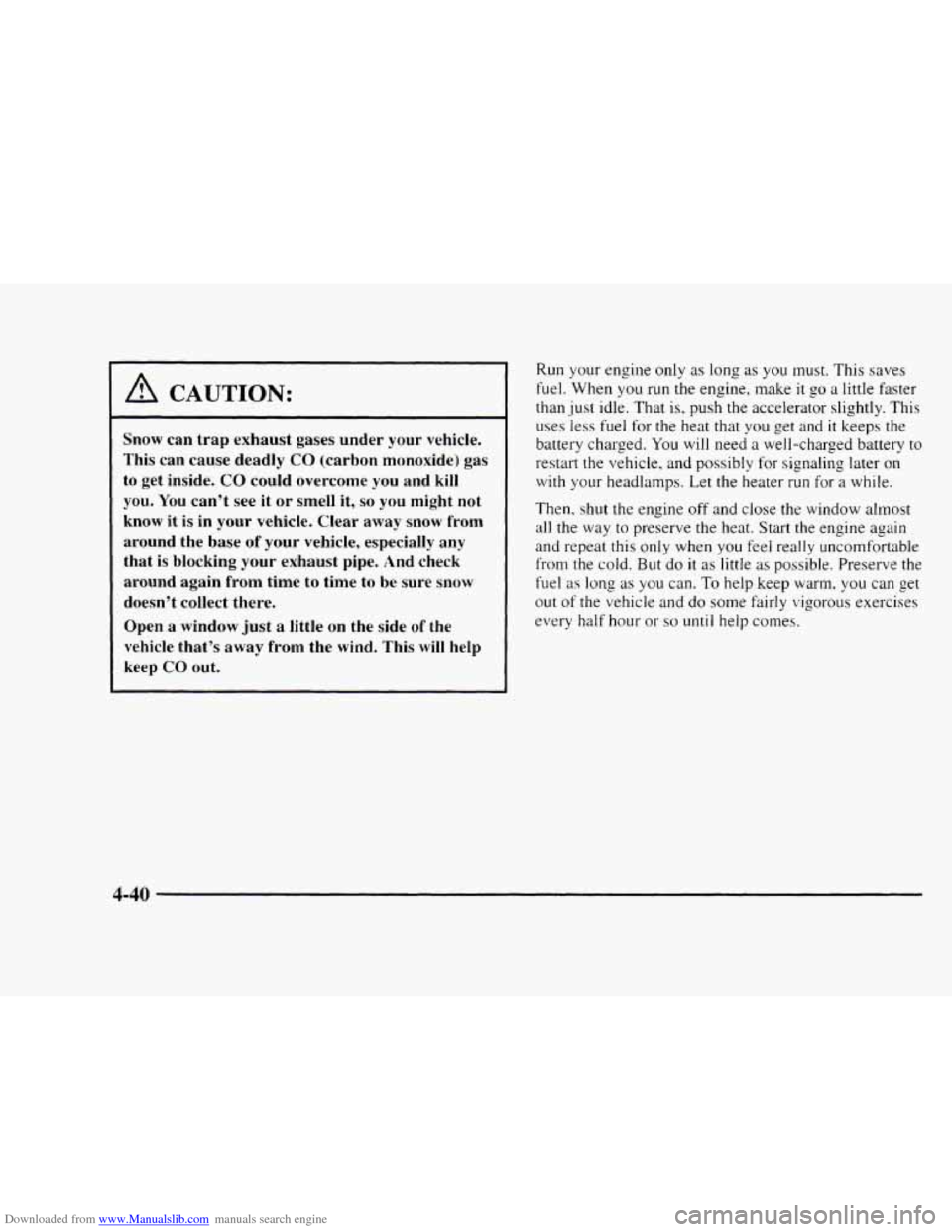
Downloaded from www.Manualslib.com manuals search engine A CAUTION:
Snow can trap exhaust gases under your vehicle.
This can cause deadly
CO (carbon monoxide) gas
to get inside.
CO could overcome you and kill
you. You can’t see it or smell it, so you might not
know it is in your vehicle. Clear away snow from
around the base of your vehicle, especially any
that
is blocking your exhaust pipe. And check
around again from time to time to be sure snow
doesn’t collect there.
Open a window just
a little on the side of the
vehicle that’s away from the wind. This
will help
keep CO out.
Run your engine only as long as you must. This saves
fuel. When
you run the engine, make it 90 a little faster
than
just idle. That is, push the accelerator slightly. This
uses less fuel for the heat that you get and it keeps the
battery charged.
You will need a well-charged battery to
restart the vehicle. and possibly for signaling later on
with your headlamps. Let the heater
run for a while.
Then. shut the engine off and close the window almost
all the way to preserve the heat. Start the engine again
and repeat this only when
you feel really uncomfortable
from the
cold. But do it as little as possible. Preserve the
fuel
as long as you can. To help keep warm. you can get
out of the vehicle
and do some fairly vigorous exercises
every
half hour or so until help comes.
4-40
Page 216 of 402
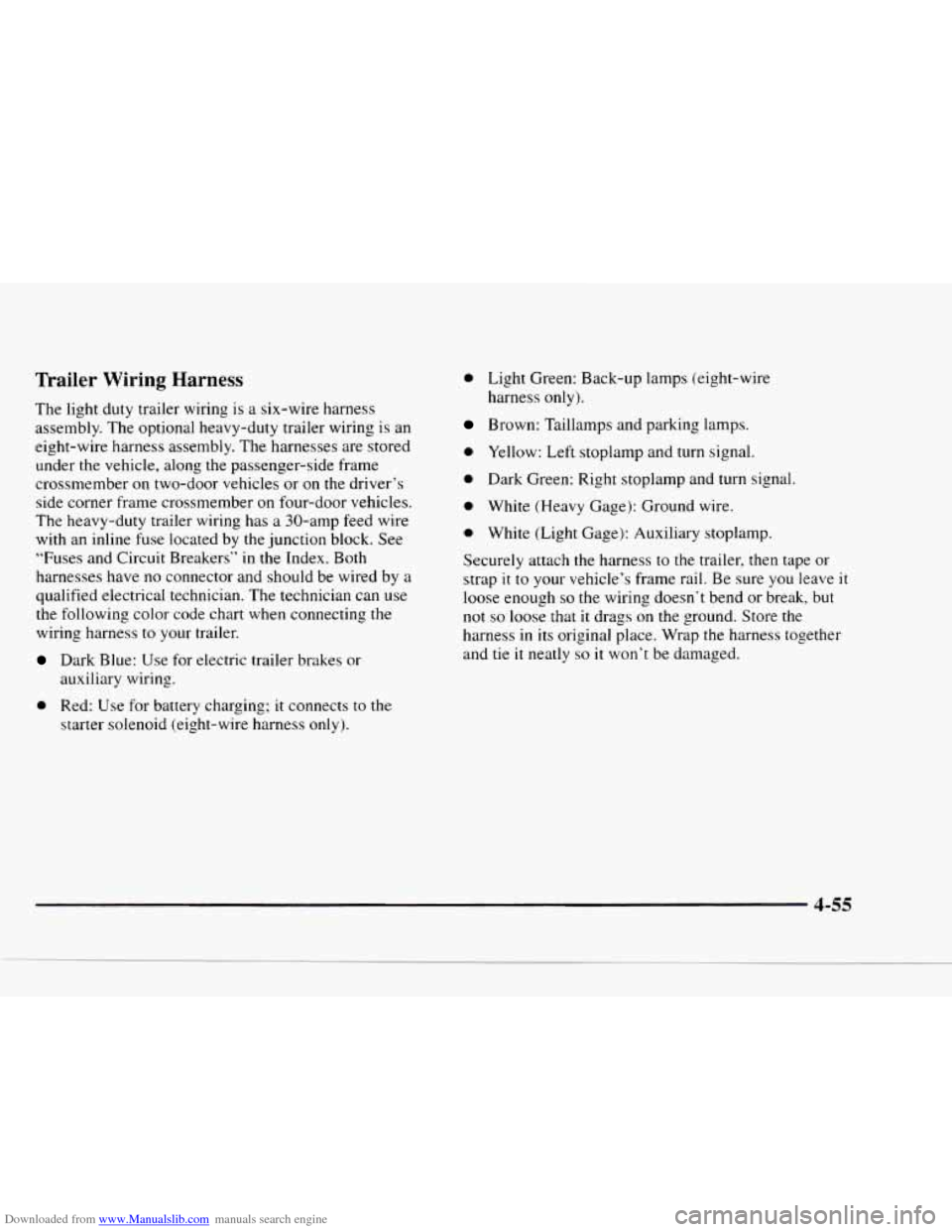
Downloaded from www.Manualslib.com manuals search engine Trailer Wiring Harness
The light duty trailer wiring is a six-wire harness
assembly. The optional heavy-duty trailer wiring is an
eight-wire harness assembly. The harnesses are stored
under the vehicle, along the passenger-side frame
crossmember on two-door vehicles or on the driver’s
side corner frame crossmember on four-door vehicles.
The heavy-duty trailer wiring has
a 30-amp feed wire
with an inline
fuse located by the junction block. See
“Fuses and Circuit Breakers”
in the Index. Both
harnesses have no connector and should be wired by a
qualified electrical technician. The technician can
use
the following color code chart when connecting the
wiring harness
to your trailer.
Dark Blue: Use for electric trailer brakes or
auxiliary wiring.
0 Red: Use for battery charging; it connects to the
starter solenoid (eight-wire harness only).
0 Light Green: Back-up lamps (eight-wire
harness only).
Brown: Taillamps and parking lamps.
0 Yellow: Left stoplamp and turn signal.
0 Dark Green: Right stoplamp and turn signal.
0 White (Heavy Gage): Ground wire.
0 White (Light Gage): Auxiliary stoplamp.
Securely attach the harness
to the trailer, then tape or
strap
it to your vehicle’s frame rail. Be sure you leave it
loose enough so the wiring doesn‘t bend or break, but
not so loose that it drags on the ground. Store the
harness in its original place. Wrap the harness together
and tie
it neatly so it won’t be damaged.
4-55
Page 221 of 402
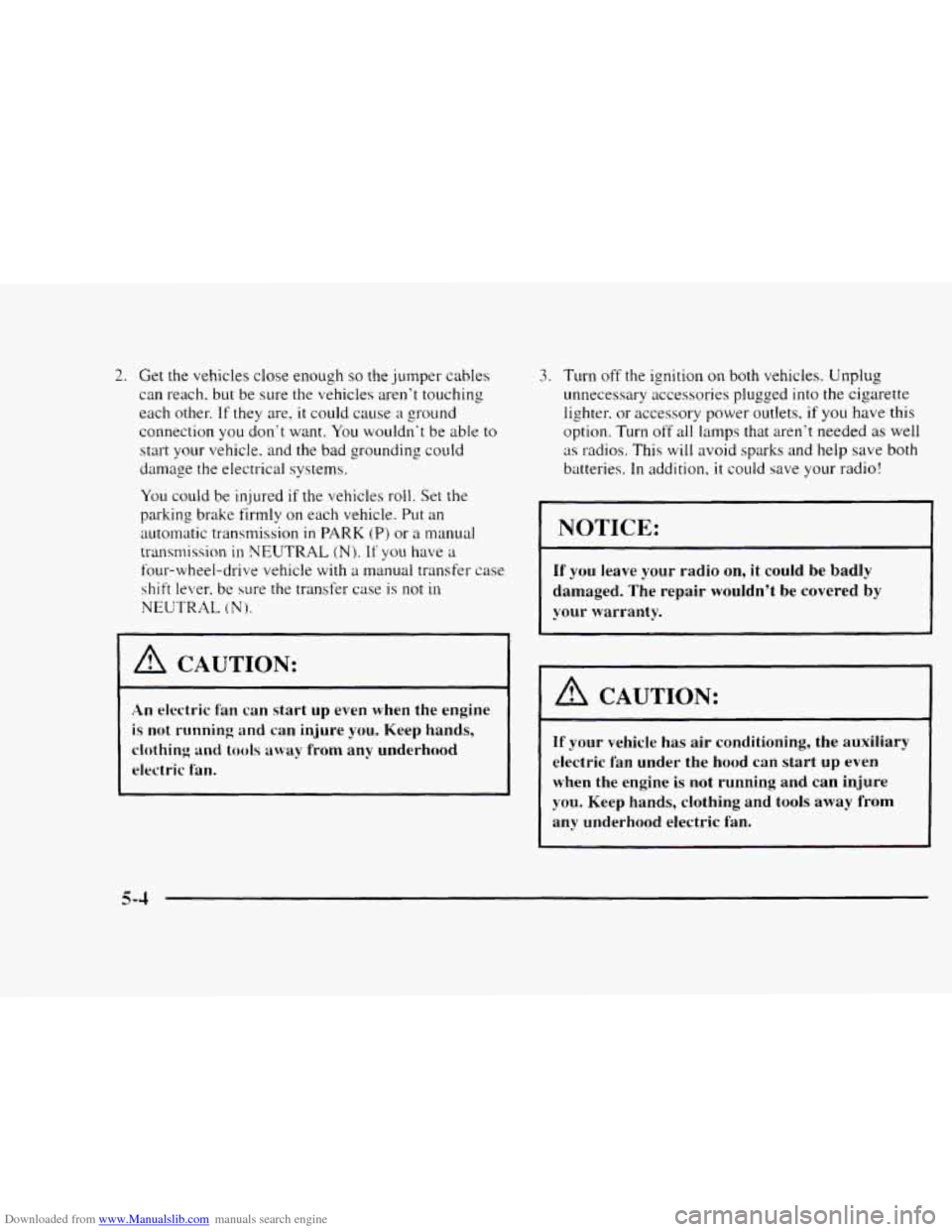
Downloaded from www.Manualslib.com manuals search engine 2. Get the vehicles close enough so the jumper cabIes
can reach. but be sure the vehicles aren't touching
each other.
If they are, it could cause a ground
connection
you don't want. You wouldn't be able to
start your vehicle. and the bad grounding could
damage the electrical systems.
You could be injured if the vehicles roll. Set the
parking brake firmly on each vehicle. Put
an
automatic transmission in PARK (Pj or a manual
transmission
in NEUTRAL (N). If you have a
four-wheel-drive vehicle with a manual transfer case
shift lever. be sure the transfer case is not
in
NEUTRAL (N).
I A CAUTION:
An electric fan can start up even when the engine
is not running and can injure you. Keep hands,
clothing and tools away from any underhood
electric
Fan.
3. Turn off the ignition on both vehicles. Unplug
unnecessary accessories plugged into
the cigarette
lighter. or accessory power outlets,
if you have this
option.
Turn off all lamps that aren't needed as well
as radios. This will avoid sparks and help save both
batteries.
In addition, it could save your radio!
I NOTICE:
If you leave your radio on, it could be badly
damaged. The repair wouldn't be covered
by
your warranty.
I A CAUTION:
If your vehicle has air conditioning, the auxiliary
electric fan under the hood can
start up even
when the engine
is not running and can injure
you. Keep hands, clothing and tools away from
any underhood electric fan.
Page 222 of 402
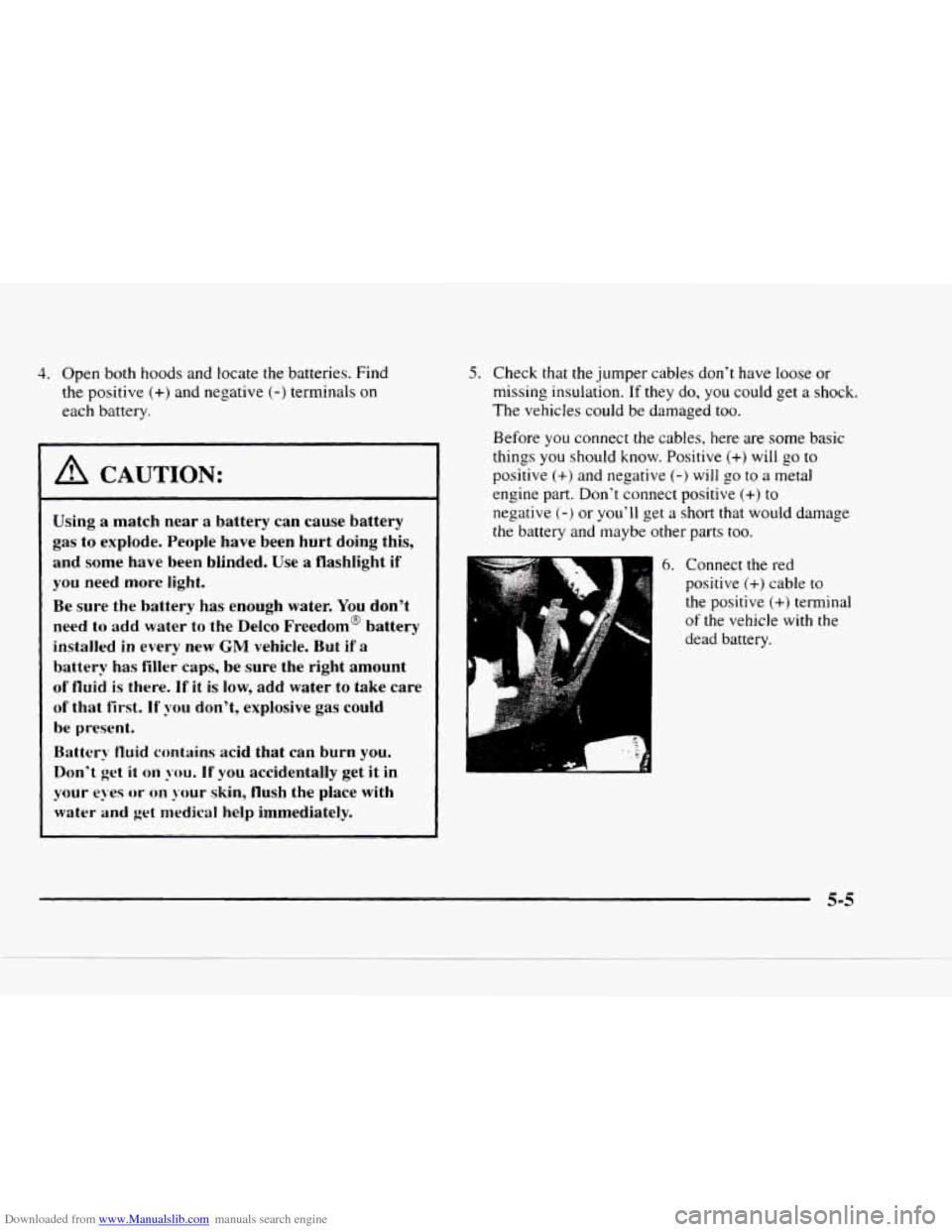
Downloaded from www.Manualslib.com manuals search engine 4. Open both hoods and locate the batteries. Find
the positive
(+) and negative (-) terminals on
each battery.
I A CAUTION:
Using a match near a battery can cause battery
gas to explode. People have been hurt doing this,
and some have been blinded. Use a flashlight if
you need more light.
Be sure the battery has enough water.
You don’t
need to add water to the Delco Freedom@ battery
installed
in every new GM vehicle. But if a
battery has filler caps, be sure the right amount
of fluid is there. If it is low, add water to take care
of that first. If you don’t, explosive gas could
be present.
Battery
fluid contains acid that can burn you.
Don’t get it on
~ou. If you accidentally get it in
your eyes
or on your skin, flush the place with
water
and get medical help immediately.
5. Check that the jumper cables don’t have loose or
missing insulation.
If they do, you could get a shock.
The vehicles could be damaged too.
Before
you connect the cables, here are some basic
things
you should know. Positive (+) will go to
positive (+) and negative (-) will go to a metal
engine part. Don’t connect positive
(+) to
negative (-) or you’ll get a short that would damage
the battery and maybe other parts too.
of the vehicle with the
dead battery.
5-5